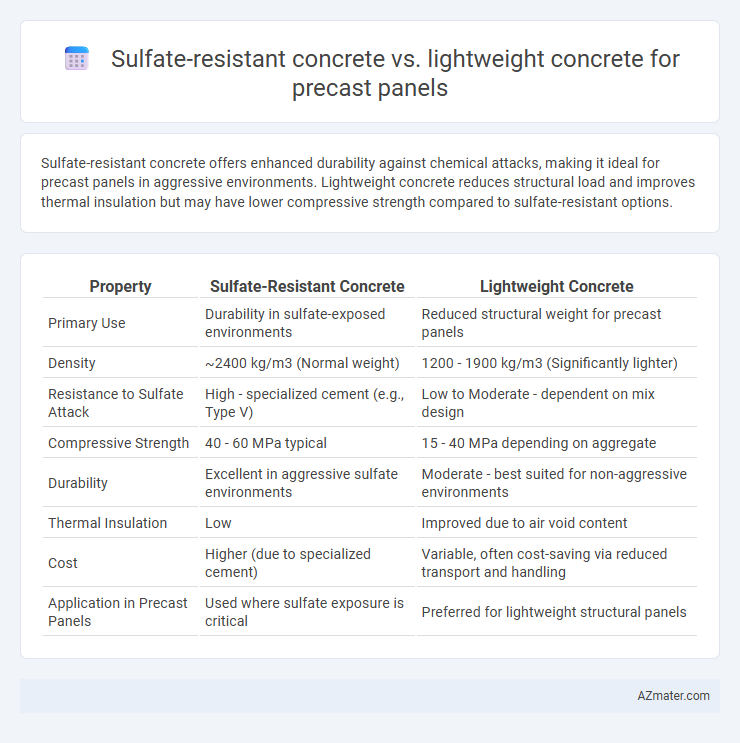Sulfate-resistant concrete offers enhanced durability against chemical attacks, making it ideal for precast panels in aggressive environments. Lightweight concrete reduces structural load and improves thermal insulation but may have lower compressive strength compared to sulfate-resistant options.
Table of Comparison
| Property | Sulfate-Resistant Concrete | Lightweight Concrete |
|---|---|---|
| Primary Use | Durability in sulfate-exposed environments | Reduced structural weight for precast panels |
| Density | ~2400 kg/m3 (Normal weight) | 1200 - 1900 kg/m3 (Significantly lighter) |
| Resistance to Sulfate Attack | High - specialized cement (e.g., Type V) | Low to Moderate - dependent on mix design |
| Compressive Strength | 40 - 60 MPa typical | 15 - 40 MPa depending on aggregate |
| Durability | Excellent in aggressive sulfate environments | Moderate - best suited for non-aggressive environments |
| Thermal Insulation | Low | Improved due to air void content |
| Cost | Higher (due to specialized cement) | Variable, often cost-saving via reduced transport and handling |
| Application in Precast Panels | Used where sulfate exposure is critical | Preferred for lightweight structural panels |
Introduction to Precast Concrete Panels
Precast concrete panels are manufactured in controlled factory environments, offering improved quality and faster installation compared to traditional cast-in-place methods. Sulfate-resistant concrete is specifically formulated to withstand harsh sulfate-rich environments, enhancing durability for panels exposed to aggressive soils or groundwater. Lightweight concrete reduces panel weight, improving handling and reducing structural load, but may not provide the same chemical resistance as sulfate-resistant mixes in aggressive conditions.
Overview of Sulfate-Resistant Concrete
Sulfate-resistant concrete is specifically designed to withstand corrosive environments by limiting the use of tricalcium aluminate in its cement composition, thereby enhancing durability against sulfate attack. It is ideal for precast panels exposed to aggressive soil or groundwater conditions, offering superior resistance to chemical deterioration compared to lightweight concrete. This type of concrete maintains structural integrity and reduces maintenance costs in infrastructure projects requiring long-term sulfate durability.
Key Properties of Lightweight Concrete
Lightweight concrete used in precast panels offers high strength-to-weight ratio and excellent thermal insulation due to its low density, typically ranging from 1,440 to 1,840 kg/m3. Its reduced dead load improves structural efficiency and decreases transportation costs, while maintaining sufficient compressive strength usually between 17 to 35 MPa. Lightweight concrete's superior fire resistance and enhanced durability against shrinkage and cracking make it an optimal choice compared to sulfate-resistant concrete, especially in non-aggressive environments.
Durability: Sulfate Resistance Comparison
Sulfate-resistant concrete for precast panels offers superior durability in environments with high sulfate exposure, effectively resisting chemical attacks that cause expansion and cracking. Lightweight concrete, while beneficial for reducing structural load, typically has lower sulfate resistance due to its higher porosity and potential for increased permeability. Selecting sulfate-resistant concrete enhances longevity and structural integrity in sulfate-rich soils or wastewater applications compared to lightweight alternatives.
Weight and Structural Performance
Sulfate-resistant concrete offers enhanced durability in aggressive environments, maintaining structural integrity by resisting chemical attack, but typically exhibits higher density and weight compared to lightweight concrete. Lightweight concrete reduces the overall panel weight, improving handling and lowering transportation costs while providing sufficient strength and thermal insulation properties in precast applications. Despite slightly lower compressive strength than sulfate-resistant mixes, lightweight concrete supports efficient structural performance where weight reduction is critical without sacrificing durability.
Installation and Handling Differences
Sulfate-resistant concrete for precast panels offers enhanced durability against chemical attacks, requiring careful curing and moisture control during installation to maintain integrity. Lightweight concrete panels provide easier handling and reduced weight, enabling faster installation with less structural load impact, but may need additional attention to prevent surface damage. Both materials demand specific handling techniques tailored to their unique properties to ensure optimal performance and longevity in field applications.
Cost Analysis: Material and Lifecycle
Sulfate-resistant concrete typically incurs higher initial material costs due to specialized cement and admixtures designed to withstand aggressive sulfate environments, impacting the upfront budget of precast panels. Lightweight concrete offers cost savings through reduced material weight, resulting in lower transportation and handling expenses, but may require additional curing time and surface treatments that affect overall lifecycle costs. Evaluating total cost of ownership involves assessing durability and maintenance frequency, with sulfate-resistant concrete often providing longer service life in harsh conditions, potentially lowering long-term repair and replacement expenses compared to lightweight alternatives.
Suitability for Various Environments
Sulfate-resistant concrete is highly suitable for precast panels used in aggressive environments exposed to sulfate-rich soils or groundwater, providing enhanced durability and minimizing chemical degradation. Lightweight concrete offers excellent thermal insulation and reduced structural load, making it ideal for precast panels in seismic zones or energy-efficient buildings but less resistant to sulfate attack. Selecting the appropriate concrete type depends on specific environmental conditions, such as sulfate exposure or structural weight limitations, ensuring long-term performance and durability.
Sustainability and Environmental Impact
Sulfate-resistant concrete enhances durability in aggressive soil environments, reducing maintenance needs and extending the lifespan of precast panels, which contributes to sustainability through resource conservation. Lightweight concrete decreases the overall weight of panels, leading to lower transportation emissions and reduced structural support requirements, thereby minimizing the carbon footprint of construction projects. Both materials improve environmental impact by optimizing longevity and reducing energy consumption during installation and use.
Choosing the Right Concrete for Precast Panels
Sulfate-resistant concrete provides enhanced durability and chemical resistance, making it ideal for precast panels exposed to aggressive environments with high sulfate concentrations. Lightweight concrete offers benefits such as reduced structural load and improved thermal insulation, which are crucial for large-scale precast panels in seismic zones or energy-efficient buildings. Selecting the right concrete depends on project requirements, including environmental exposure, structural performance, and insulation needs.

Infographic: Sulfate-resistant concrete vs Lightweight concrete for Precast panel
 azmater.com
azmater.com